You are currently exploring the Fundamentals Library, which is designed to provide a basic overview of the topics that are covered in other longer articles. This article is a part of the Progression section.
Progression Models
The progression model is a planned increase in objective training demands to maintain relative training demands, with the supposition that progression has occurred.
The supposition that progression has occurred means that our progression model is typically based on a hypothesis. We assume that we will get better at a certain rate. However, this is just an estimate that we make based on an athlete's training history and characteristics.
We distinguish two different types of progression models:
- Fixed Progression Models
- Autoregulative Progression Models
In this article, we will focus on autoregulative progression models. We will discuss the specific methodology behind them and talk about their utility.
Autoregulative Progression Models
Unlike fixed progression models, autoregulative models of progression account for fluctuations in performance. As the name suggests, they use autoregulation. While autoregulation is a broad concept, it can be used to adjust the objective demands of training based on our ability to perform in a given session.
The basic idea is that in addition to exercise induced fatigue, there are other factors that determine performance on a given day. These things are related to our sleep and nutrition, as well as stress during the day, which can come from a large pool of events. These factors have the potential to cause our performance to fluctuate from day to day.
Therefore, one idea of autoregulative progression models is to keep the intent of scaling up requirements, but filter them through our performance levels, using the proximity to failure measurement (such as RPE or Reps in reserve) as a metric of effort. Before we get to the progression models themselves, we need to understand some basic terminology that I have created to help us categorize different aspects of the models in the case of an autoregulative progression style:
Pattern refers to the general trajectory of the progression, the most common ones are:
- Linear
- Step
Linear pattern means increasing a certain variable by some amount every single training session. Step pattern means that we increase, then next session (or a couple of sessions) we leave the same weight to increase it again afterwards.
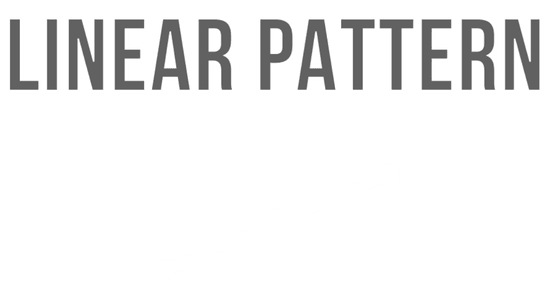
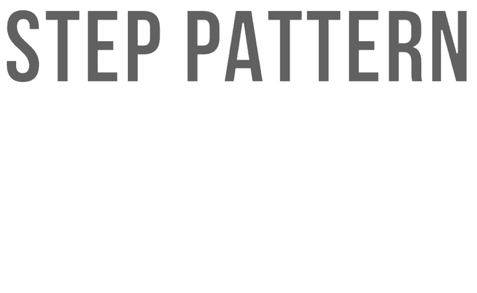
Scheme refers to the structure of the battery of sets in terms of repetition number:
- Straight Sets
- Reverse Pyramid
- Pyramid*
Straight sets refer to the scheme where each set is done with the same number of reps (for example 5x5). Reverse pyramid means reps increase along with the sets as load decreases (for example 5/3/1). Pyramid approach is the opposite, the repetitions go down across the set battery and load increases (for example 15/10/5). Pyramid method is rarely used in strength training as we can suspect it is not as effective in that regard.

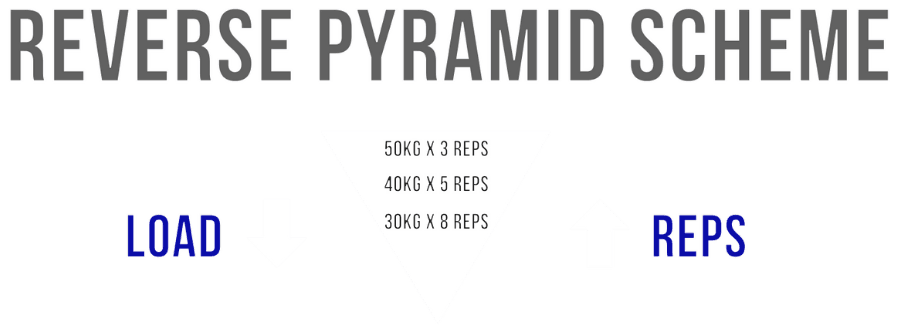
Strategy refers to the approach of increasing the demands:
- Set Battery
- Individual Set
Set battery strategy refers to increasing a certain variable across all sets when a certain goal is set across them (for example increasing from 3x5 to 3x6). Individual set strategy separates the sets and allows for looking independently at each set as separate in terms of progression.
Once we have the understanding of the processes above. There are three fixed progression models that can be applied:
- Load Progression
- Double Progression
- Volume Progression*
We won’t discuss volume progression in this article as I think it is not a method designed with strength training in mind, and it could be seen more as a periodisation model rather than progression model. More on that in some other article.
There are also a couple of terms distinctive for autoregulative style of progression programming. These are:
- RPE Range refers to the range of proximity to failure that we work with
- RPE Lower Threshold refers to the proximity to failure that going below is a trigger to applying progression (moving load or repetitions/seconds up)
- RPE Upper Threshold refers to the proximity to failure that going above is a trigger to applying regression (moving load or repetitions/seconds up)
- Consecutive Successful Set/Session refers to the consecutive number of sets completed below RPE lower threshold or the sessions completed with all sets below RPE lower threshold.
- Consecutive Unsuccessful Set/Sessionrefers to the consecutive number of sets completed above RPE top threshold or sessions completed with all sets above RPE bottom threshold.
As RPE Range is the foundation of the model, let’s assume that for the following parts of the article, we are going to use the range of RPE [7-9]. Meaning, 7 is our lower threshold and 9 is our upper threshold.
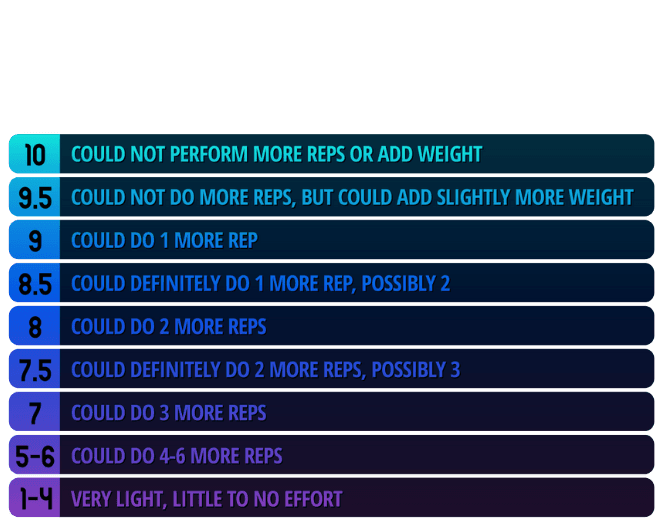
Autoregulative Load Progression
Autoregulative load progression uses the idea of increasing the amount of resistance used in an exercise while keeping other variables the same - and at the same time staying within an RPE Range. Autoregulative load progression can be implemented using several different patterns, schemes and strategies.
The progression pattern can be linear or step. This will depend on whether we add a rule of consecutive successful sessions or sets. We may decide to add a rule that we need 2 consecutive successful or unsuccessful sessions before applying progression or regression.
The linear pattern would look in a following way:
| Session 1 | 50 KG × 5 (RPE 8) | 5 (RPE 8) | 5 (RPE 9) |
| Session 2 | 50 KG × 5 (RPE 7) | 5 (RPE 7) | 5 (RPE 8) |
| Session 3 | 50 KG × 5 (RPE 6) | 5 (RPE 6) | 5 (RPE 6) |
| Session 4 | 52.5 KG × 5 (RPE 7) | 5 (RPE 7) | 5 (RPE 8) |
The step pattern, assuming the goal of 2 consecutive successful sessions would look in a following way:
| Session 1 | 50 KG × 5 (RPE 8) | 5 (RPE 8) | 5 (RPE 9) |
| Session 2 | 50 KG × 5 (RPE 7) | 5 (RPE 7) | 5 (RPE 8) |
| Session 3 | 50 KG × 5 (RPE 6) | 5 (RPE 6) | 5 (RPE 6) |
| Session 4 | 50 KG × 5 (RPE 7) | 5 (RPE 7) | 5 (RPE 7) |
| Session 5 | 50 KG × 5 (RPE 6) | 5 (RPE 6) | 5 (RPE 6) |
| Session 6 | 52.5 KG × 5 (RPE 5) | 5 (RPE 6) | 5 (RPE 6) |
Within these load progression patterns, there are also different schemes you can use to structure your sets and reps. This doesn’t differ at all from the fixed progression methods.
Straight Sets are one of the most commonly used schemes, where you perform the same number of repetitions across all sets. The most popular are 3 sets of 10 reps, 5 sets of 5 reps (5x5), 3 sets of 5 reps (3x5), and 3 sets of 3 reps (3x3), but obviously, any configuration here is available.
Another popular scheme is Reverse Pyramid Training. In RPT, you start with your heaviest set with the most load, and then reduce the load* for subsequent sets. There are different variations of RPT, such as performing a set of standard sets with a moderate weight after the top set, followed by a back-off set with an even lighter load.
In both of these schemes, we can use different strategies for adding load. The ones recommended for this model are set battery strategy - which in this context will mean adding load to each set of the exercise:
| Session 1 | 50 KG × 5 (RPE 7) | 5 (RPE 8) | 5 (RPE 7) |
| Session 2 | 50 KG × 5 (RPE 6) | 5 (RPE 7) | 5 (RPE 7) |
| Session 3 | 50 KG × 5 (RPE 6) | 5 (RPE 6) | 5 (RPE 7) |
| Session 4 | 50 KG × 5 (RPE 6) | 5 (RPE 6) | 5 (RPE 7) |
| Session 5 | 50 KG × 5 (RPE 5) | 5 (RPE 6) | 5 (RPE 6) |
| Session 6 | 52.5 KG × 5 (RPE 7) | 5 (RPE 8) | 5 (RPE 7) |
or individual set strategy - meaning we will add weight independently, set by set:
| Session 1 | 50 KG × 5 (RPE 7) | 50 KG × 5 (RPE 8) | 50 KG × 5 (RPE 7) |
| Session 2 | 50 KG × 5 (RPE 6) | 50 KG × 5 (RPE 7) | 50 KG × 5 (RPE 7) |
| Session 3 | 52.5 KG × 5 (RPE 7) | 50 KG × 5 (RPE 6) | 50 KG × 5 (RPE 7) |
| Session 4 | 52.5 KG × 5 (RPE 6) | 52.5 KG × 5 (RPE 7) | 50 KG × 5 (RPE 6) |
| Session 5 | 55 KG × 5 (RPE 8) | 52.5 KG × 5 (RPE 6) | 52.5 KG × 5 (RPE 7) |
Fixed Load Progression - Recommendations
When it comes to loading increments, the amount by which you increase the load can vary depending on your experience level and the exercise you're performing but also based on the RPE range. The larger the RPE range, the more abrupt our load increment can be.
The load can be increased based on percentage, a fixed number of kilograms, or by making the variation of the exercise more difficult, which would be typically required in the case of calisthenics.
Autoregulative Load Progression - Which Exercises?
Just as fixed load progression, due to its dependence on some level of sensitivity in load selection, this method is strictly reserved for exercises performed with external resistance, ideally one that can be easily tracked and manipulated in an incremental manner.
The exercises that match this description are barbell exercises as well as externally loaded calisthenics exercises. The caveat is, if you want an extra level of sophistication, in the latter ones you may actually track your body weight and adjust the external weight in such a way that your daily body weight also dynamically contributes to the load.
Static weight exercises (which are rarely being performed) could be technically trained with this method, and if you happen to do so in an exercise that is well trackable, just use seconds instead of repetitions.
Autoregulative Double Progression
Let’s explore the second system that can be implemented, which is Autoregulative Double Progression.
The word “double” simply refers to the fact that the process of increasing load is broken down to two separate stages and happens on two tracks. We first increase the repetitions or seconds, and when we achieve a given goal number of repetitions, we increase the load. And the process of increasing repetitions is also based on the RPE Range like in the load progression.

Autoregulative Double progression, just like load progression, can be applied in different patterns, schemes and strategies.
One approach is to progress with a set battery, where all sets are put into one basket, and the load is increased in all sets once each one of them achieves a certain goal:
| Session 1 | 50 KG × 5 (RPE 6) | 5 (RPE 6) | 5 (RPE 7) |
| Session 2 | 50 KG × 5 (RPE 5) | 5 (RPE 6) | 5 (RPE 6) |
| Session 3 | 50 KG × 6 (RPE 6) | 6 (RPE 6) | 6 (RPE 7) |
| Session 4 | 50 KG × 6 (RPE 5) | 6 (RPE 6) | 6 (RPE 6) |
| Session 5 | 50 KG × 7 (RPE 6) | 7 (RPE 7) | 7 (RPE 7) |
| Session 6 | 50 KG × 7 (RPE 5) | 7 (RPE 6) | 7 (RPE 6) |
| Session 7 | 55 KG × 5 (RPE 7) | 5 (RPE 7) | 5 (RPE 7) |
On the other hand, we can also progress on an individual set basis, where each set progresses independently:
| Session 1 | 50 KG × 5 (RPE 6) | 50 KG × 5 (RPE 6) | 50 KG × 5 (RPE 7) |
| Session 2 | 50 KG × 6 (RPE 5) | 50 KG × 6 (RPE 6) | 50 KG × 5 (RPE 6) |
| Session 3 | 50 KG × 7 (RPE 6) | 50 KG × 7 (RPE 7) | 50 KG × 6 (RPE 7) |
| Session 4 | 55 KG × 5 (RPE 5) | 50 KG × 7 (RPE 6) | 50 KG × 6 (RPE 6) |
| Session 5 | 50 KG × 6 (RPE 6) | 55 KG × 5 (RPE 7) | 50 KG × 7 (RPE 7) |
| Session 6 | 50 KG × 7 (RPE 5) | 55 KG × 5 (RPE 6) | 50 KG × 7 (RPE 6) |
Autoregulative Double Progression - Recommendations
Just like in the fixed double progression, the general rule is that the larger the range of repetitions increases, the more load we can add once the upper threshold is achieved.
RPE Thresholds should not be too large, as increasing 1 repetition of the exercise is typically easier to achieve than reducing the RPE of a given set from 9 to 6. This is why I would recommend a tighter RPE Range (that still makes the thresholds detectable).
Sometimes, the range must be extended, due to problems with incremental load selection, as in many calisthenics specific cases. Adding repetitions or seconds should then happen linearly or in a step fashion.
Autoregulative Double Progression - Which Exercises?
The usage of this method can be justified for the same reasons as the fixed double progression. Apart from the ones mentioned in the autoregulative load progression, it will suit exercises with dumbbells, kettlebells, or bands, which provide a less incremental system of progression. Therefore, increasing repetitions could be a nice gap in between, for example, taking another dumbbell, which could be 10% heavier than the previous one.
Another obvious group that will benefit from it is bodyweight exercises, where the load is simply difficult to define objectively.



